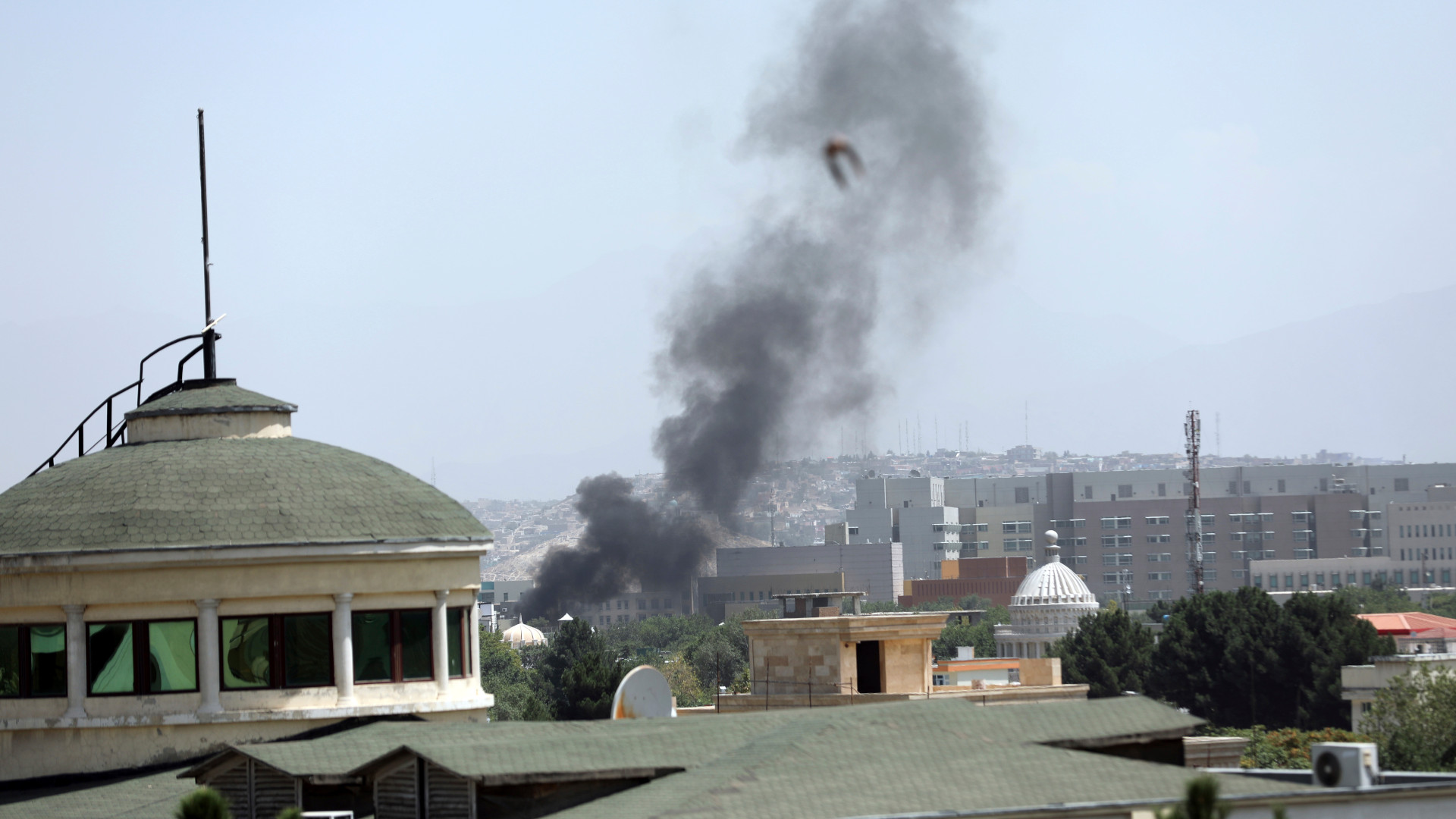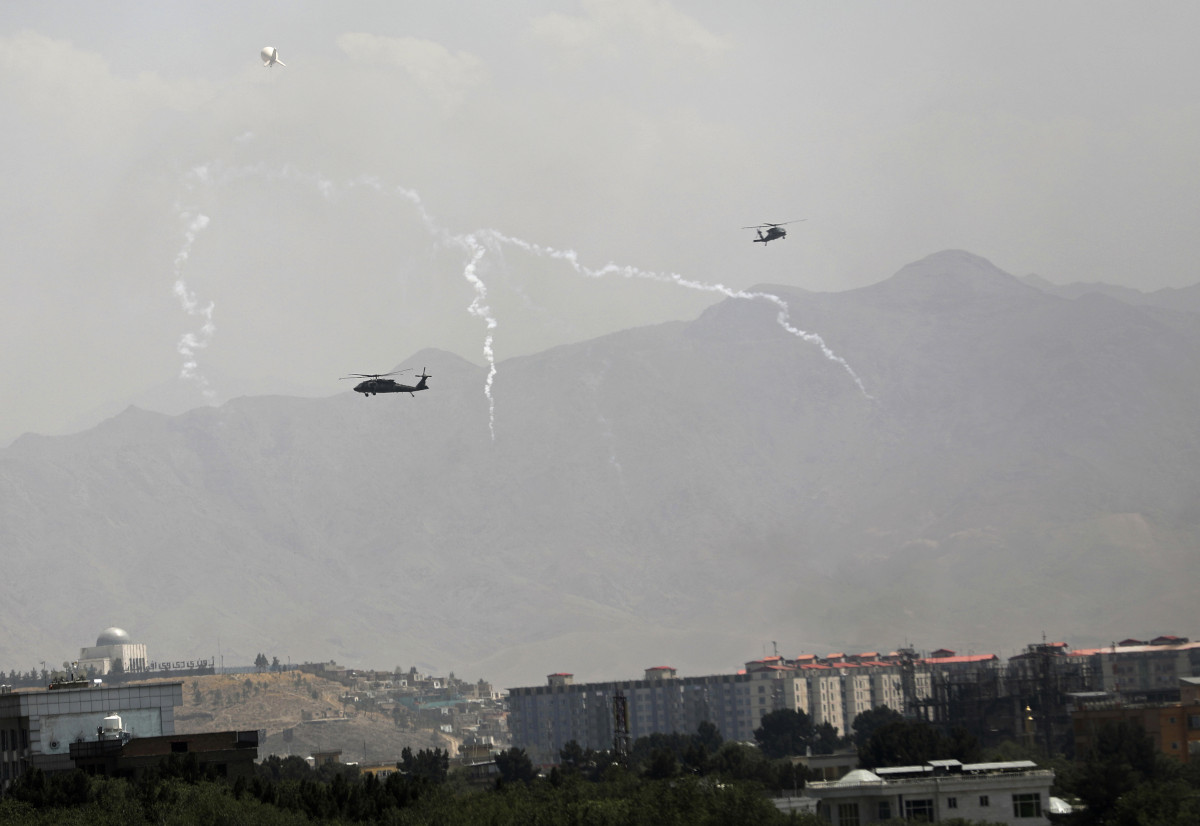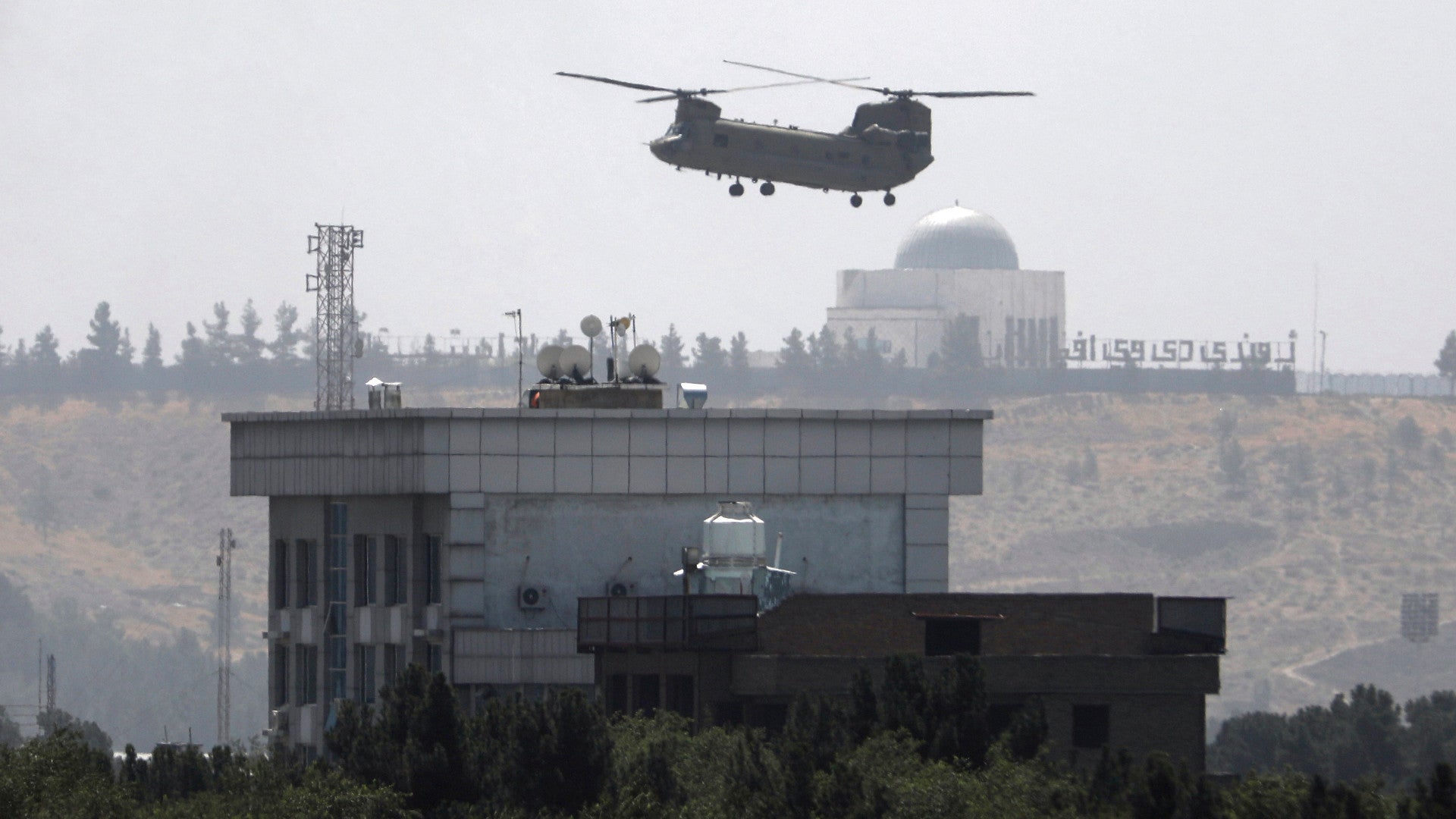The situation is changing very rapidly in the Afghan capital of Kabul. The speed and effectiveness of the Taliban’s blitz to regain control of the country has taken the U.S. and its allies by surprise. Now, it appears that Kabul will fall before the United States and other foreign powers that have violently opposed the Taliban for two decades can safely get their nationals out of the country.
The U.S. Embassy in Kabul is now all but shut down and smoke had been seen rising from the compound earlier in the day suggesting sensitive documents were being burned. A steady stream of helicopters belonging to the U.S. military and the U.S State Department has been seen ferrying American personnel to nearby Hamid Karzai International Airport, where other aircraft will then take them out of the country. All of this comes after the Taliban entered the city today and amid reports that Afghan President Ashraf Ghani fled the country after resigning as part of a deal to establish a new, interim, transitional government.


Pictures and video coming out of the war-torn country have shown U.S. Army CH-47F Chinooks and U.S. State Department CH-46 Sea Knights flying to and from the Embassy compound. The War Zone had reported last month about how the latter helicopters, as well as other State Department aircraft, would be very important assets for moving Americans to safety if the security situation in the country continued to deteriorate. The Sea Knights had already long served as the primary mode of transportation for U.S. diplomatic staff and other U.S. government personnel between the Embassy and Hamid Karzai International Airport due to security concerns, as you can read more about here.
The imagery of the evacuations in Kabul is already drawing comparisons to the fall of Saigon, then the capital of South Vietnam, in 1975, though the circumstances of the two events are significantly different in a host of aspects. The optics, however, are very similar.
CH-47s, as well as Army UH-60 Black Hawks, have also been spotted conducting operations around Kabul, including firing off infrared decoy flares. There have not been any reports, at least as of yet, that any American helicopters have come under attack, so it is possible that these flares were part of a show of force to deter individuals, including members of the Taliban or other actors, on the ground in some way. There have been reports that ground convoys, which the Black Hawks could be helping to escort, have also been moving from the Embassy to the airport. It could also just be the standard protocol for helicopters flying the city at present given the increasing threat situation.

It’s unclear whether or not the State Department’s own Black Hawks have been involved in any of the evacuation operations so far. The War Zone
reported last month about how those helicopters, as well as other State Department aircraft, could be very important assets for moving Americans to safety if the security situation in the country continued to deteriorate.
Photographs of Hamid Karzai International Airport taken yesterday showed Chinooks and Black Hawks, as well as Army AH-64 Apache attack helicopters and U.S. Air Force HC-130J Combat King II rescue aircraft on the ground. As The War Zone had reported just days ago, online flight tracking data had already shown a U.S. military evacuation airbridge was forming that included various types of aircraft, including at least six highly specialized KC-135RT “receiver tanker” aerial refueling aircraft that can be refueled in flight themselves, which you can read more about here.
The total U.S. military force posture in Kabul at present is unclear. Just yesterday, President Joe Biden announced that a total of 5,000 troops would help U.S. diplomatic staff and others evacuate. This figure includes 1,000 personnel already on the ground in the Afghan capital, plus the previously announced deployments of 3,000 Marines and Army soldiers, which began this past Friday, as well as an additional 1,000 personnel from the Army’s 82nd Airborne Division. Those elements of the 82nd are part of a larger contingent that was originally supposed to go entirely to Kuwait to be better positioned to provide additional support if required. Other countries are now moving to deploy their own rescue forces, as well.

How many of these troops will ultimately deploy to Afghanistan remains to be seen given how rapidly the situation in the country is devolving. Just this past week, the Taliban were able to secure virtually all major population centers across the country and isolate Kabul, weeks before recent U.S. government assessments had predicted they would be able to do so. The group did so through a combination of military victories and negotiations with local power brokers that saw government-aligned forces defeated, driven from the battlefield, or simply convinced to abandon their posts or even defect.
All told, it seems increasingly unlikely that the country’s current internationally recognized government will exist in any recognizable form in the next 24 hours. It’s not entirely unclear where talks between the existing administration in Kabul and the Taliban stand now, but Abdul Sattar Mirzakwal, Afghanistan’s acting Interior Minister, had already announced that a “peaceful transfer of power” was coming. A picture subsequently emerged purporting to show Afghan President Ghani embracing Taliban officials.
There are reports that Ghani has now fled Afghanistan. Other reports had said that the expectation was that Ghani would resign and that former interior minister Ahmad Jalali will then take control of an interim, transitional government, with a Taliban-led government, possibly led by Mullah Abdul Ghani Baradar, then taking over. Mullah Baradar is the Taliban’s co-founder and head of its political wing, and has been involved in past negotiations with the U.S. government via an office established in Doha in Qatar. He also notably met with Chinese officials in July and China is among the countries that have reportedly been preparing for weeks now to recognize a Taliban government in Afghanistan if Ghani’s administration were to fall.
It’s also not clear how this could impact the United States’ plans to try to help Afghans who worked with the U.S. military or parts of the U.S. government, who are now at serious risk of reprisals from the Taliban, evacuate the country. The New York Times
has reported that the current operations to get people out of the Embassy have not included Afghans working there.
There have also been reports that, at least until just recently, the U.S. government was still urging other Americans, as well third-country nationals, to leave the country themselves by any means available, raising questions about whether there are plans for a larger-scale noncombatant evacuation operation (NEO). Some commercial flights do still appear to be taking off from Hamid Karzai International Airport, but it’s unclear how long that will continue, and the Taliban effectively control all of the country’s major overland border crossings.
Other options for where to stage evacuation flights are equally limited. The U.S. military notably turned over Bagram Airfield just outside of Kabul, which had been a major operational hub for American and coalition operations for years, to the Afghan government in July and it is now under Taliban control.
This has also brought up questions about what options might be realistically available for regular Afghans, many of who are trying to flee Kabul ahead of the formal Taliban takeover. The group has issued statements promising limited disruptions in daily life in the country after it assumes power, but many are still reasonably fearful about the potential for all manner of freedoms to be severely curtailed, and worse, under a new hardline Islamic regime.
Whatever happens next, the situation is already extremely embarrassing for the U.S. government, which had spent nearly 20 years conducting counterterrorism operations in Afghanistan and otherwise leading an international coalition that was also committed to establishing a functional Afghan government and military. Thousands of American and coalition troops gave their lives in Afghanistan over the past two decades and tens of thousands of Afghan security forces and civilians have also died in the fighting.
Still, despite the obvious seriousness of the situation the U.S. government continues to downplay the significance, on multiple levels, of what is happening on the ground.
“Let’s take a step back. This is manifestly not Saigon,” U.S. Secretary of State Antony Blinken said today, pointing to the impacts the U.S. intervention had on Al Qaeda, the terrorist group responsible for the 9/11 attacks, which prompted the entire affair in the first place back in 2001. “That message should ring out very strongly.”
Of course, there is no guarantee that Al Qaeda, or another similar terrorist group, will not subsequently take advantage of the situation in Afghanistan now. It’s also important to remember that Al Qaeda founder and long-time public enemy number one of the United States, Osama Bin Laden, was ultimately killed in a raid on a compound in neighboring Pakistan, not in Afghanistan. Any future American intervention into Afghanistan would also be made more difficult by the experience the Taliban has gained over the past two decades and the substantial amount of U.S. and other foreign-supplied military equipment, which includes aircraft, artillery, and armored vehicles, it has now captured from the country’s security services.
“The Taliban is not the North Vietnamese Army, they’re not,” President Biden had said back in July. “They’re not remotely comparable in terms of capability. There’s going to be no circumstance for you to see people being lifted off the roof of an embassy of the United States from Afghanistan. It is not at all comparable.”
“The likelihood there is going to be the Taliban overrunning everything and owning the whole country is highly unlikely,” he added.
If nothing else, that assertion has proven to be manifestly false. Overall, the current situation in Afghanistan would seem to reflect serious failures in the intelligence assessments about the Taliban’s capabilities and intentions, as well as those of the Afghan government, and as a worrying lack of appropriate planning for large-scale evacuation operations.
It is hard to imagine a worse place to be in if the U.S. government now has to rely on the goodwill and mercy of the Taliban to complete the evacuation of Americans and any other individuals it is hoping to help get out of the country.
We will continue to monitor the situation in Afghanistan as it continues to develop and will make updates as new information emerges.
Update 1:15 PM EST:
The U.S. State Department has issued two alerts in the last few hours, with the first telling all American nationals to shelter in place and warning that they should not attempt to get to Hamid Karzai International Airport as it appeared to be under attack. It also said that the Embassy had suspended consular services. The second notice did not say anything specifically about consular services or attempting to get to the airport. The exact present security situation at Hamid Karzai International Airport is unclear.
There are separate reports that the bulk of American personnel from the Embassy have been relocated to the airport, from where they will continue to oversee the ongoing evaluation operations, among other duties. Ross Wilson, the U.S. Chargé d’Affaires, is reportedly among those at the airport now and may have the U.S. flag that had flown above the building with him. Wilson is not technically the U.S. Ambassador to Afghanistan, a post that is currently vacant, though he has been acting in this role.
The exact state of the U.S. evacuation plan, and who American forces expect to help leave the country, is also still murky. Only 1,200 Afghans who may qualify for Special Immigrant Visas (SIV) had been airlifted out as of Friday.
The plan for the transition to a new Taliban government also appears to be changing with the departure of President Ghani from the country. Former President Hamid Karzai has said that he, along with Chairman of the High Council for National Reconciliation Abdullah Abdullah, and warlord Gulbuddin Hekmatyar, will lead a transitional council.
There are also rumors that Ghani fleeing the country may have prompted the Taliban to adopt a more aggressive stance, and the group says it now plans to officially declare their new Islamic Emirate of Afghanistan soon. There are unconfirmed reports that the former Afghan President was supposed to take part in a ceremony to mark the transition of power, which would have given the process added legitimacy.
Update 1:40 PM EST:
Reuters is now reporting that Hamid Karzai International Airport has been closed to commercial aircraft, according to a NATO official. It’s unclear if this would include aircraft chartered by foreign governments.
Video has also emerged showing what appears to be a mass of people loading onto a C-17A Globemaster III airlifter belonging to the United Arab Emirates (UAE) Air Force at Hamid Karzai International Airport. It’s unclear when this clip was taken.
Update 3:55 PM EST:
VOA is reporting that unknown actors are still directing sporadic gunfire at Hamid Karzai International Airport and that US forces are “trying to take care of it.” Military evacuation operations are ongoing while civilians are also still trying to leave the country via the airport.
Additional troops from the U.S. Army’s 82nd Airborne Division are now headed for Kabul to ensure the safe completion of the evacuations. Currently, around 6,000 American troops are expected to deploy to the Afghan capital, in total.
The Taliban have also now held an exclusive press conference with Al Jazeera from the Presidential Palace. One of the group’s members told the outlet that he had been in the U.S. military’s detention center at Guantanamo Bay in Cuba for eight years.
We have concluded our updates to this story. You can find our continuing coverage of the still-evolving crisis in Afghanistan here.
Contact the author: joe@thedrive.com
